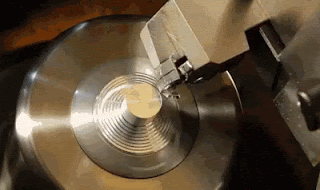Turning Tools and Their Geometry
Cutting tools, used on lathes to cut away material from the
work piece and bring the required shape, are called turning tools. These are
generally single point tools, means; they have only one cutting edge. Different
types of turning tools are used for different operations.
 |
| Turning Tool Working |
General Nomenclature of Turning Tools
Geometry of a Turning Tool
Some commonly used Turning Tools
1. Side Cutting Tool
It is also known as Knife tool, this tool is mainly used
when a square shoulder is required on the work piece. This is an orthogonal
cutting tool cuts, a nose radius of 0.5 to 1 mm should be given. A larger nose
radius may cause chattering and vibration of the work piece and therefore not
advisable for finishing long slender work pieces.
2. Roughing tool
This is called a roughing tool, because it can be remove
more material for the same tool life of a side cutting tool but it can be used
for finishing also. This is an oblique cutting tool, Therefore it produces a
third component of the cutting force which is directed along the radius of the
work piece, which may tend to push the work piece away. This may cause
chattering and vibration on thin and long work pieces, and spoil the finish. If
this tool is made with 45○ approach angle, it can be used advantageously
for chamfering also which saves a lot of time.
3. Recessing Tool
Also Called as Grooving tool, this tool is used for turning
recesses or grooves. For this purpose it is fed right angular to the axis of
the rotating work piece. Length of the cutting edge is made equal to or less
than the width of the recess. The operation of grooving is done at a slower
speed than longitudinal turning.
4. Parting off Tool
This is similar to recessing tool except that is approach
angle to ensure that the piece is cut off without leaving projection.
5. Threading Tools
The point of the tools is accurately ground to the shape of
the thread which they have to cut and with zero rake angle. Due to the zero
rake angle, the form of the tool is not changed even after repeated re-sharpening.
However, for roughing, rake angle may be given, but finishing cuts must be made
with a tool having zero rake angles.
Turning Tools and their Geometry
 Reviewed by Tools on Blog
on
June 13, 2018
Rating:
Reviewed by Tools on Blog
on
June 13, 2018
Rating:
 Reviewed by Tools on Blog
on
June 13, 2018
Rating:
Reviewed by Tools on Blog
on
June 13, 2018
Rating:










No comments: